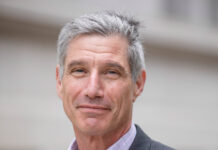On Aug. 9, Michael Brown, an unarmed, 18-year-old African American, was shot and killed by Darren Wilson, a white police officer, after being suspected of robbing a convenience store in Ferguson, Missouri. It is unclear if a struggle occurred, as police records and witness testimonies differ. Primarily peaceful protests followed Brown’s death, but police with military-grade weaponry were dispatched to quell the rioting that did occur.
The Slippery Rock Amnesty International Club held a roundtable discussion Thursday night in Spotts Auditorium in response to the protests and circumstances surrounding Brown’s death.
The discussion included a panel of six expert speakers and an opportunity for students to ask questions and express their opinions regarding the events in Ferguson.
Slippery Rock University Department of History Professor Dr. Aaron Cowan, said that a disproportionately white police force and neglected living areas are a historical backdrop to the type of unnecessary police force seen in Ferguson to begin the panel.
He added, “Ferguson is not the ghetto,” and does not represent the most extreme case of racism and segregation in America today. Cowen said that police have come to represent white power due to double standards in police force upon blacks and whites.
Another panelist, sociology professor Dr. Richelle Dykstra, said the events represent ingrained political, social and economic inequity in Ferguson. “We have to turn our attention to the system and be hard on the system,” she said, indicating that the system prevents us from seeing others as humans and from seeing the larger issues. Society needs to move beyond symbolism, such as hoodies and skittles, as seen in the Trayvon Martin case of 2012, and create activism, Dykstra said.
Other panelists, such as Dr. Heather Rice, a political science professor and also the advisor to the Amnesty International Club, said that the majority white government versus the majority black population in Ferguson creates a divide between who governs and who is governed. Dr. David Kershaw, another political science professor, said that a modern form of racism was at play in Ferguson, saying, “A lot of people don’t see color, but we feel color.”
Panelist Corinne Gibson, director of the Office of Multicultural Development, attributed the rioting in Ferguson to a feeling of invisibility in the black community. “I was raised that the police are bad, they don’t help you,” Gibson said. “The best way to fix this problem is to vote for politicians who want to help the community and to, “pause, plan, and participate.”
During the question session, a Missouri native spoke up, attributing the events in Ferguson to strong organization of the Klu Klux Klan, a white-supremacist group, in Missouri and an overall disorganization of black groups.
One white student, referring to Darren Wilson, the police officer that shot Brown, said “We portray black people as thugs, who’s to say he shouldn’t be afraid?”
“Listen, he is a grown man,” replied a black student.
When one student asked why the peaceful protests in Ferguson following Brown’s death were met with a disproportionate police response, Gibson said, “It’s all about displaying their power. I’m here you’re there.”
In response to a student question regarding public protection when police break the law, Dykstra, a white woman, said, “If I’m pulled over, I’m not going to get searched, even though I’m more likely to have drugs than anyone else.” Laughter followed her statement.
Gibson concluded the event by addressing the black audience.
“Give yourselves permission to be angry,” she said.







